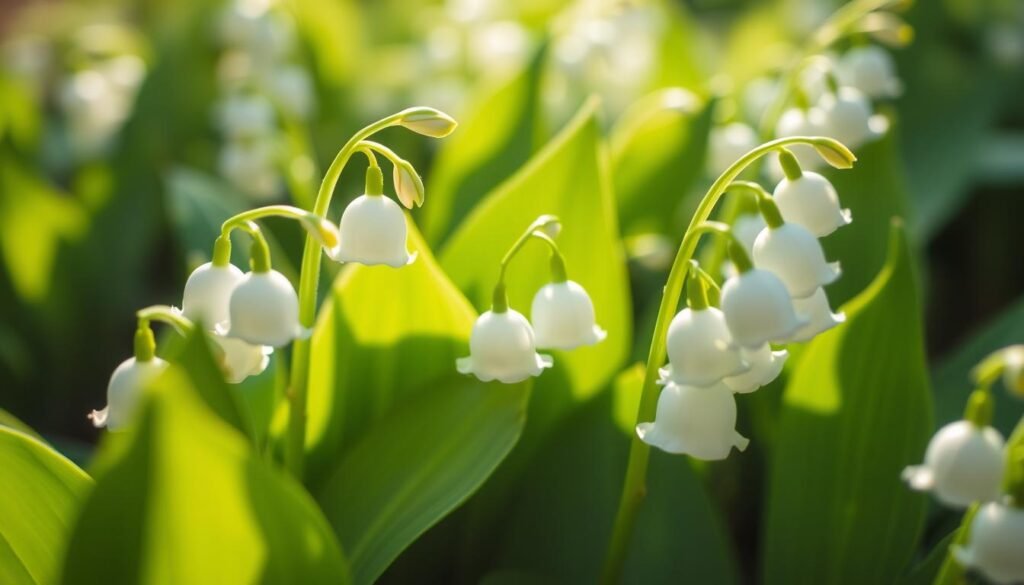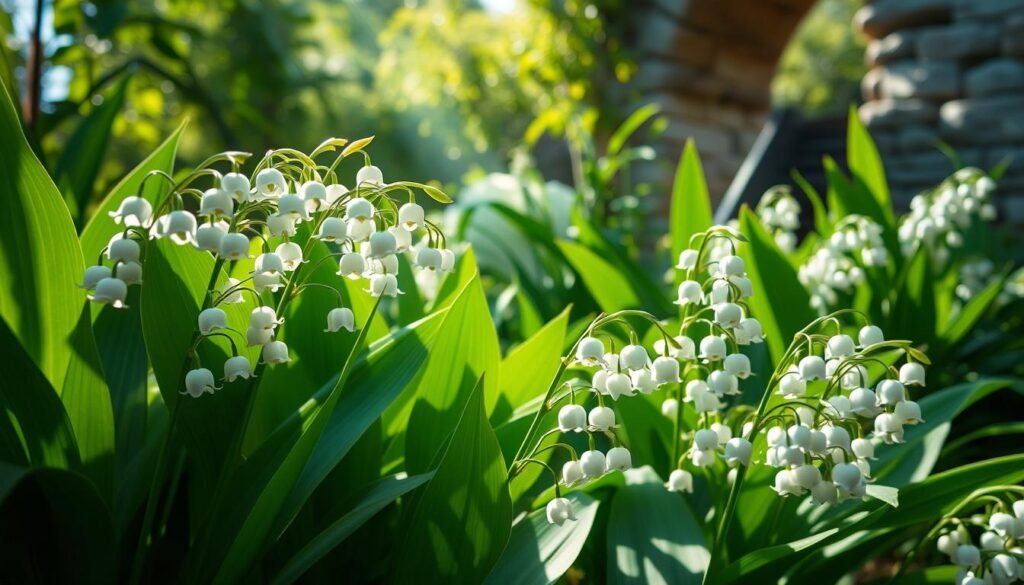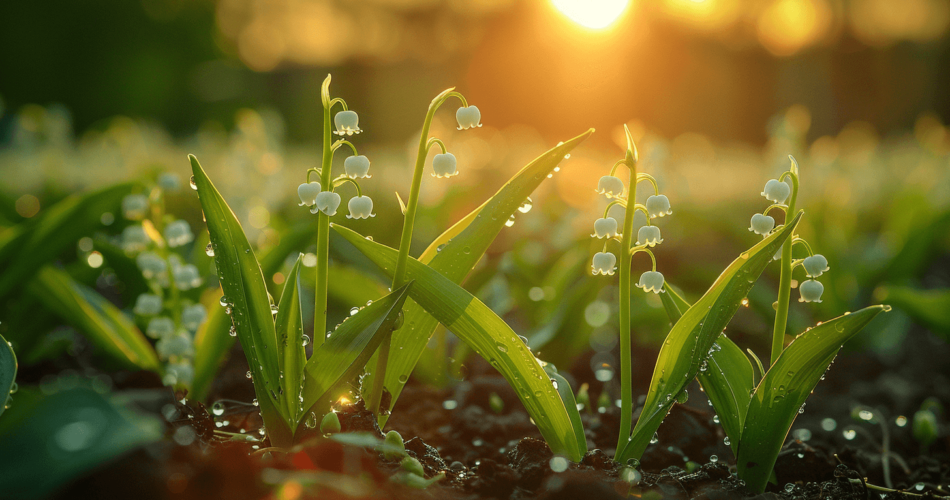What’s the story behind the lily of the valley flower? Its delicate blooms and deep cultural meaning make it special. It’s the May birth flower, known for its scent, symbolic value, and ability to grow well. Let’s explore its history, care, and interesting facts together.
Related Post: Birth Flowers for all 12 months

Key Takeaways
- Lily of the Valley is a hardy, shade-loving perennial that thrives in zones 3-9.
- It is known for its tough, reliable ground cover properties and minimal maintenance requirements.
- The flower symbolizes happiness, prosperity, contentment, renewal, and hope.
- Lily of the Valley is not actually a lily but part of the asparagaceae plant family.
- Proper care and cultivation can prevent the plant from becoming invasive.
What is Lily of the Valley Flower?
Lily of the valley (Convallaria majalis) is a delicate, shade-loving perennial plant. It is known for its small, bell-shaped white or pink flowers and lush green foliage. These flowers grow in low-growing clusters and bloom in the late spring, typically between May and June.
With their captivating fragrance and charming appearance, lily of the valley flowers have long been beloved. They are known for their ability to evoke the joyful arrival of the spring season.
The plant typically grows from 15 to 30cm tall, with a spread of 0.75 to 1.00 feet. Lily of the valley flowers bloom from March to June, exuding an intensely sweet scent during this time. In some countries like Austria, these plants are protected and not allowed to be picked from the wild.
The Meaning of Lily of the Valley
The lily of the valley flower has deep roots in culture. It goes back to myths, religions, and old traditions. Its delicate, bell-shaped blooms symbolize purity, humility, and the return of joy.
Symbolism and Cultural Significance
In the Victorian era, the Lily of the valley was seen as a sign of happiness coming back. In ancient times, it was connected to the goddess Ostara and the Greek god Apollo. Today, it’s still very important, especially in France, where it’s given on May 1st for luck and happiness.
The lily of the valley is mentioned 15 times in the Bible. It’s also Finland’s national flower. Plus, Queen Elizabeth II included it in her coronation bouquet in 1953. This shows its royal and traditional ties.
The lily of the valley flower’s rich history and meaning make it a favorite worldwide. It’s a symbol of joy and purity, loved by many cultures and through time.
May Birth Flower
The lily of the valley is the official birth flower for May. It’s a symbol of spring with its sweet, delicate blooms. These flowers welcome warmer weather and are loved for May birthdays and spring events. Related Post: May’s Birth Flowers
May also has another birth flower, the hawthorn. Both flowers have deep meanings and rich histories. They are special in their own ways.
The lily of the valley is a member of the asparagus family. It has white, bell-shaped flowers with a lovely scent. These flowers are linked to motherhood, purity, and good luck. They’re often seen in weddings and bridal bouquets.
Many royal brides, like Kate Middleton and Princess Diana, have carried lily of the valley bouquets.
Whether it’s a May birthday or just enjoying the season, the lily of the valley and hawthorn are great choices. They add beauty and meaning to any celebration. These flowers truly capture May’s spirit.
Fragrance and Aroma
The Delightful Scent of Lily of the Valley
The lily of the valley is known for its amazing fragrance. These flowers have a light, perfumy scent that smells like spring. Their lily of the valley flower fragrance is used in many perfumes, from classic to modern scents.
The lily of the valley flower scent is fresh and floral, with a hint of sweetness. Perfumers love it because it pairs well with other flowers like rose and jasmine. It’s also found in lotions and soaps for its beauty and skin benefits.
The lily of the valley flower fragrance is a big hit in perfumery. Famous brands like Christian Dior, Guerlain, and Yves Saint Laurent have made famous perfumes with this scent. It’s a timeless favorite among fragrance lovers everywhere.
| Fragrance House | Notable Lily of the Valley Fragrances |
|---|---|
| Christian Dior | Diorissimo (1956) |
| Guerlain | Muguet (1908) |
| Yves Saint Laurent | Yvresse (1993) |
Historical Significance
The lily of the valley flower has a long history, dating back centuries. It holds deep cultural significance in Europe and Asia. The Convallaria majalis plant is known for its symbolic meaning and medicinal uses.
In the Middle Ages, the lily of the valley was brought from Japan to Europe. In the 16th century, giving these flowers on May 1st started in France. King Charles IX made it a tradition to celebrate the start of spring and good luck.
This tradition, called La Fête du Muguet, spread quickly. It made the lily of the valley a symbol of good fortune.
The flower is also tied to biblical stories, Greek myths, and Romanian folklore. In Christian art, it stands for purity and humility. It’s mentioned in the Song of Solomon 2:1.
In folk traditions, the lily of the valley is seen as a protective charm. It’s believed to keep away evil and bad luck. Its toxic nature adds to its mystique, making it a powerful shield against harm.
Today, the lily of the valley flower still holds a special place in many cultures. Its history and symbolism continue to fascinate people worldwide.

Biblical Connections
Lily of the Valley in the Bible
The lily of the valley is very important in Christianity. It’s mentioned in the Bible many times. In the Song of Solomon, it stands for the beloved, showing purity and humility.
It’s also linked to Eve’s tears after leaving the Garden of Eden. Some call it “our lady’s tears” because of the Virgin Mary’s sorrow over Jesus’ death. This has made the lily of the valley a symbol of holiness and divine grace.
Even though the lily of the valley isn’t directly named in most English Bibles, scholars connect it with other flowers in the text. For example, the “lily of the valleys” in Song of Solomon 2:1 is seen as a symbol of Jesus Christ, showing His purity and the hope of His return.
The lily of the valley is also thought to have healing powers, both physically and spiritually. Its white flowers represent purity, life, and hope. This makes it a perfect symbol of the virtues found in the Bible.
| Statistic |
|---|
| The Bible mentions lilies 15 times in 15 different verses, with 8 mentions occurring in the Song of Solomon. |
| “Lily of the valleys” is mentioned in Song of Solomon 2:1, considered a type of Jesus Christ by most Bible students. |
| The Easter Lily (Latin: Lilium longiforum) is native to the southern islands of Japan. |
| The United States became a major source for the Easter Lily during World War II. |
| The Easter Lily requires three to four years of close care to produce the quality expected today. |
| An area on the California-Oregon border became known as the Easter Lily capital. |
| The Easter Lily has become the traditional flower of Easter and symbolizes purity, life, good, innocence, and hope. |

The lily of the valley is also tied to motherhood in poetry and myths. This strengthens its link to the Virgin Mary and the themes of purity and renewal in Christianity.
Toxicity Warning
The lily of the valley flower is beautiful, but it’s dangerous. All parts of the plant, like flowers, leaves, and berries, have toxic chemicals. These can harm humans and pets if eaten.
Eating a small bit of the lily of the valley can cause stomach problems and slow heart rate. It can even be deadly. Kids often eat the berries thinking they’re food. Pets can also get sick if they eat it.
While the flowers are okay to touch, wash your hands well after handling the plant. Lily of the valley can harm the heart, stomach, and nervous system. It can also affect your vision and skin. Signs of poisoning include tight chest, diarrhea, and dizziness.
Even though the lily of the valley is pretty, be careful. Keep it away from kids, pets, and anyone who might eat it. Knowing the dangers helps you enjoy its beauty safely.
Planting and Growing
Growing the lily of the valley flower is a rewarding task. It loves partial to full shade and moist, well-draining soil. The best time to plant is in late fall, when it’s cool.
Tips for Cultivating Lily of the Valley
Plant the rhizomes 6 inches apart and 1/2 inch deep. After it’s established, it needs little care. Just water it when it’s dry and divide it every few years to keep it growing.
- Plant rhizomes 6 inches apart and 1/2 inch deep in the late fall
- Provide partial to full shade and consistently moist, well-draining soil
- Water during dry spells and divide overcrowded colonies every few years
- Lily of the valley is hardy in USDA Zones 3-8
- Avoid planting in hot climates above Zone 9
By following these tips, you can enjoy how to grow lily of the valley in your garden. The lily of the valley plant care is easy, making it perfect for all gardeners. With the right lily of the valley growing conditions, it will bloom beautifully for years.
Care and Maintenance
Proper care for freshly cut lily of the valley flowers can make them last longer. Cut the stems when a quarter of the buds are open. Remove any foliage that will fall below the water line in the vase. Then, place the stems in a smaller container filled with clean, cool water.
To keep your lily of the valley flowers looking great, maintain the right conditions. Keep them in a cool spot with moderate light. Also, change the water every other day to keep them fresh and vibrant. With a bit of care, these spring beauties can brighten your space for up to a week.
- Cut lily of the valley stems when about a quarter of the buds are open
- Remove any foliage that will fall below the water line in the vase
- Place the stems in a smaller container filled with clean, cool water
- Keep the cut flowers in a cool location with moderate light
- Change the water every other day to keep the blooms fresh
- Properly cared for, lily of the valley flowers can last up to a week after being cut
By following these simple lily of the valley flower care tips, you can enjoy their beauty and fragrance for days. Cut them from your garden and watch them brighten your space.
Royal and Fashion Connections
The lily of the valley is a special flower in the world of royalty and fashion. It symbolizes purity, happiness, and new beginnings. Its ties to the British royal family and the fashion world are amazing.
Queen Elizabeth II chose lily of the valley for her coronation bouquet in 1953. It was a favorite of hers, often seen in Buckingham Palace’s floral displays. Kate Middleton also included it in her wedding bouquet in 2011.
In fashion, the lily of the valley is closely tied to Christian Dior. Dior believed it brought luck and had it in his dresses. Today, Dior celebrates it with tableware and home decor.
The lily of the valley’s lasting appeal in royalty and fashion shows its timeless beauty. It’s a symbol of elegance and sophistication. It’s part of our cultural heritage, thanks to its royal and fashion connections.
The lily of the valley continues to enchant people worldwide. Its royal and fashion ties make it even more special. It stands for purity, happiness, and the beauty of nature.
Conclusion
The lily of the valley flower has amazed people for centuries. It has deep roots in culture and the Bible. It’s also linked to royalty and high fashion.
This delicate flower is loved for its scent, meaning, and beauty. It’s a true delight to behold.
Gardeners and perfume lovers can enjoy the lily of the valley. It adds beauty to gardens and fragrance to perfumes. The lily of the valley flower shows nature’s lasting beauty and its power to inspire us.
Our journey through the flower shows its lasting charm. It will continue to amaze and inspire many. Whether you love gardening, nature, or just beauty, the lily of the valley will capture your heart and mind.
FAQ
What is the lily of the valley flower?
The lily of the valley is a spring flower loved for its delicate blooms and sweet scent. It’s a perennial plant in the asparagus family.
What is the meaning and symbolism of the lily of the valley flower?
This flower stands for purity, humility, and happiness. It’s tied to mythology, religion, and culture. It symbolizes happiness in the Victorian era and is linked to Ostara and Apollo.
Why is the lily of the valley the birth flower for May?
The lily of the valley is May’s birth flower. It fits the spring season with its fragrant blooms. It’s a symbol of May’s arrival.
What is the captivating fragrance of the lily of the valley?
The lily of the valley is famous for its light, spring-like scent. This scent is used in many perfumes.
What is the historical significance of the lily of the valley?
The lily of the valley has a long history. It was first brought to Europe in the Middle Ages. In the 16th century, French King Charles IX gave it on May 1st to celebrate spring and work.
Is the lily of the valley flower toxic?
Yes, it’s toxic. The plant contains chemicals that can harm if eaten. It can cause stomach problems and heart issues in humans and pets.
How do I grow and care for lily of the valley flowers?
Growing lily of the valley is easy. It likes shade and moist soil. Plant it in late fall. It needs little care, just water and divide when needed.
What is the connection between the lily of the valley and royalty and high fashion?
The lily of the valley is linked to royalty and fashion. It was in Queen Elizabeth II’s coronation bouquet. It’s also in Kate Middleton’s wedding bouquet. In fashion, it’s special, especially for Christian Dior.
Source Links
- https://www.longfield-gardens.com/article/all-about-lily-of-the-valley/ – All About Lily of the Valley
- https://www.interflora.ie/flower-types/lily-of-the-valley – The Ultimate Guide to Lily of the Valley
- https://www.southernliving.com/garden/lily-of-the-valley – How To Grow And Care For Lily Of The Valley
- https://www.housebeautiful.com/uk/garden/plants/a41245028/lily-of-the-valley/ – Everything you need to know about lily of the valley (Convallaria majalis)
- https://www.lovingly.com/flower-meanings/lily-of-the-valley – Lily of the Valley – Flowers – Featured Content – Lovingly
- https://www.countryliving.com/gardening/a41229643/lily-of-the-valley-meaning-symbolism/ – The Special Meaning Behind Queen Elizabeth’s Favorite Flower
- https://www.almanac.com/content/may-birth-flowers – May Birth Flowers: Lily-of-the-Valley and Hawthorn
- https://www.floraly.com.au/blogs/news/may-birth-flowers-lily-of-the-valley-hawthorn – May Birth Flowers & Meanings: Lily of the Valley & Hawthorn
- https://www.alphaaromatics.com/blog/lily-of-the-valley/ – Lily-Of-The-Valley As An Essential Component Of Fragrances
- https://phlur.com/blogs/perfumery-dictionary/lily-of-the-valley-scent-in-perfumery – What Does Lily Of The Valley Smell Like In Perfume?
- https://www.bonparfumeur.com/blogs/journal/lily-of-the-valley-in-perfumery – Lily of the valley perfumes | Bon Parfumeur Paris
- https://thursd.com/articles/lily-of-the-valley-cultural-significance – Uncover Lily of the Valley Symbolism
- https://en.wikipedia.org/wiki/Lily_of_the_valley – Lily of the valley
- https://www.woodlandtrust.org.uk/trees-woods-and-wildlife/plants/wild-flowers/lily-of-the-valley/
- https://plantura.garden/uk/flowers-perennials/lily-of-the-valley/lily-of-the-valley-overview – Lily of the valley: flowers, varieties & toxicity – Plantura
- https://www.missouribotanicalgarden.org/PlantFinder/PlantFinderDetails.aspx – Convallaria majalis – Plant Finder
- https://www.brecks.com/collections/lily-of-the-valley – Lily of the Valley Flower Plants For Sale | Breck's
- https://www.learnthebible.org/the-lily-of-the-valley.html – The Lily of the Valley | Learn The Bible | LearnTheBible.org
- https://www.mygodmorning.com/post/the-lily-of-the-valleys – The Lily of the Valleys
- https://insightfulspiritual.com/interpreting-biblical-significance-of-the-lily-of-the-valley/ – Interpreting Biblical Significance of the Lily of the Valley
- https://www.mountsinai.org/health-library/poison/lily-of-the-valley – Lily of the valley Information | Mount Sinai
- https://www.webmd.com/first-aid/lily-of-the-valley-poisoning – Lily of the Valley Poisoning
- https://plantura.garden/uk/flowers-perennials/lily-of-the-valley/is-lily-of-the-valley-poisonous – Is lily of the valley poisonous to humans & pets? – Plantura
- https://www.bhg.com/gardening/plant-dictionary/perennial/lily-of-the-valley/ – How to Plant and Grow Lily of the Valley
- https://www.almanac.com/plant/lily-valley – How to Grow Lily of the Valley: The Complete Lily of the Valley Flower Guide
- https://www.gardeningknowhow.com/ornamental/bulbs/lily-of-the-valley/growing-lily-of-the-valley.htm – How To Grow And Care For Lily Of The Valley Flowers
- https://www.thespruce.com/lily-of-the-valley-2132623 – How to Grow Lily of the Valley
- https://plantura.garden/uk/flowers-perennials/lily-of-the-valley/planting-lily-of-the-valley – Planting lily of the valley: expert tips – Plantura
- https://www.gardendesign.com/flowers/lily-of-the-valley.html – Grow Lily-of-the-Valley Flowers – Garden Design
- https://www.wholeblossoms.com/wedding-flowers-blog/enchant-your-wedding-day-with-the-magic-of-lily-of-the-valley-florals/ – Enchant Your Wedding with Lily of the Valley Magic Florals
- https://lamberdebieflowers.wordpress.com/tag/lily-of-the-valley/ – lily of the valley – Lamberdebie’s Blog
- https://www.thecelticfarm.com/lily-of-the-valley/ – Discover the Charm of Lily of the Valley: A Comprehensive Garden Guide
- https://hellofearless.com/blogs/blog/lily-of-the-valley-flower-meaning – Lily Of The Valley Flower Meaning, Spiritual Symbolism, Color Meaning & More
- https://anahanaflower.com/blogs/flowers/lily-of-the-valley-the-delicate-and-fragrant-flower-for-the-month-of-may – Lily of the Valley: The Delicate and Fragrant Flower for the Month of

